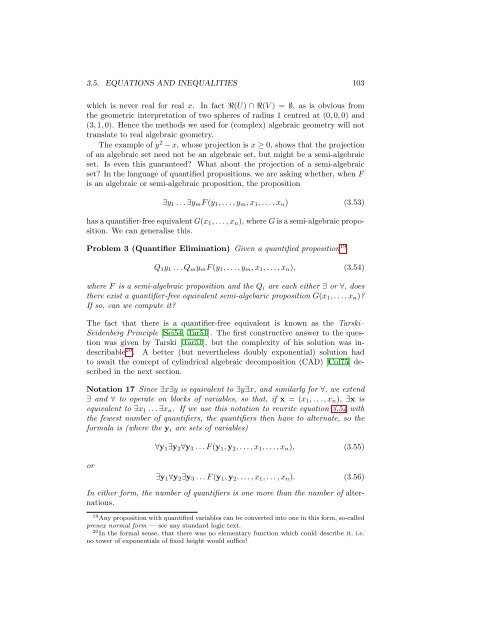Contents - Student subdomain for University of Bath
Contents - Student subdomain for University of Bath
Contents - Student subdomain for University of Bath
You also want an ePaper? Increase the reach of your titles
YUMPU automatically turns print PDFs into web optimized ePapers that Google loves.
3.5. EQUATIONS AND INEQUALITIES 103<br />
which is never real <strong>for</strong> real x. In fact R(U) ∩ R(V ) = ∅, as is obvious from<br />
the geometric interpretation <strong>of</strong> two spheres <strong>of</strong> radius 1 centred at (0, 0, 0) and<br />
(3, 1, 0). Hence the methods we used <strong>for</strong> (complex) algebraic geometry will not<br />
translate to real algebraic geometry.<br />
The example <strong>of</strong> y 2 − x, whose projection is x ≥ 0, shows that the projection<br />
<strong>of</strong> an algebraic set need not be an algebraic set, but might be a semi-algebraic<br />
set. Is even this guaranteed? What about the projection <strong>of</strong> a semi-algebraic<br />
set? In the language <strong>of</strong> quantified propositions, we are asking whether, when F<br />
is an algebraic or semi-algebraic proposition, the proposition<br />
∃y 1 . . . ∃y m F (y 1 , . . . , y m , x 1 , . . . , x n ) (3.53)<br />
has a quantifier-free equivalent G(x 1 , . . . , x n ), where G is a semi-algebraic proposition.<br />
We can generalise this.<br />
Problem 3 (Quantifier Elimination) Given a quantified proposition 19<br />
Q 1 y 1 . . . Q m y m F (y 1 , . . . , y m , x 1 , . . . , x n ), (3.54)<br />
where F is a semi-algebraic proposition and the Q i are each either ∃ or ∀, does<br />
there exist a quantifier-free equivalent semi-algebaric proposition G(x 1 , . . . , x n )?<br />
If so, can we compute it?<br />
The fact that there is a quantifier-free equivalent is known as the Tarski–<br />
Seidenberg Principle [Sei54, Tar51]. The first constructive answer to the question<br />
was given by Tarski [Tar51], but the complexity <strong>of</strong> his solution was indescribable<br />
20 . A better (but nevertheless doubly exponential) solution had<br />
to await the concept <strong>of</strong> cylindrical algebraic decomposition (CAD) [Col75] described<br />
in the next section.<br />
Notation 17 Since ∃x∃y is equivalent to ∃y∃x, and similarly <strong>for</strong> ∀, we extend<br />
∃ and ∀ to operate on blocks <strong>of</strong> variables, so that, if x = (x 1 , . . . , x n ), ∃x is<br />
equivalent to ∃x 1 . . . ∃x n . If we use this notation to rewrite equation 3.54 with<br />
the fewest number <strong>of</strong> quantifiers, the quantifiers then have to alternate, so the<br />
<strong>for</strong>mula is (where the y i are sets <strong>of</strong> variables)<br />
∀y 1 ∃y 2 ∀y 3 . . . F (y 1 , y 2 , . . . , x 1 , . . . , x n ), (3.55)<br />
or<br />
∃y 1 ∀y 2 ∃y 3 . . . F (y 1 , y 2 , . . . , x 1 , . . . , x n ). (3.56)<br />
In either <strong>for</strong>m, the number <strong>of</strong> quantifiers is one more than the number <strong>of</strong> alternations.<br />
19 Any proposition with quantified variables can be converted into one in this <strong>for</strong>m, so-called<br />
prenex normal <strong>for</strong>m — see any standard logic text.<br />
20 In the <strong>for</strong>mal sense, that there was no elementary function which could describe it, i.e.<br />
no tower <strong>of</strong> exponentials <strong>of</strong> fixed height would suffice!












![[Luyben] Process Mod.. - Student subdomain for University of Bath](https://img.yumpu.com/26471077/1/171x260/luyben-process-mod-student-subdomain-for-university-of-bath.jpg?quality=85)



